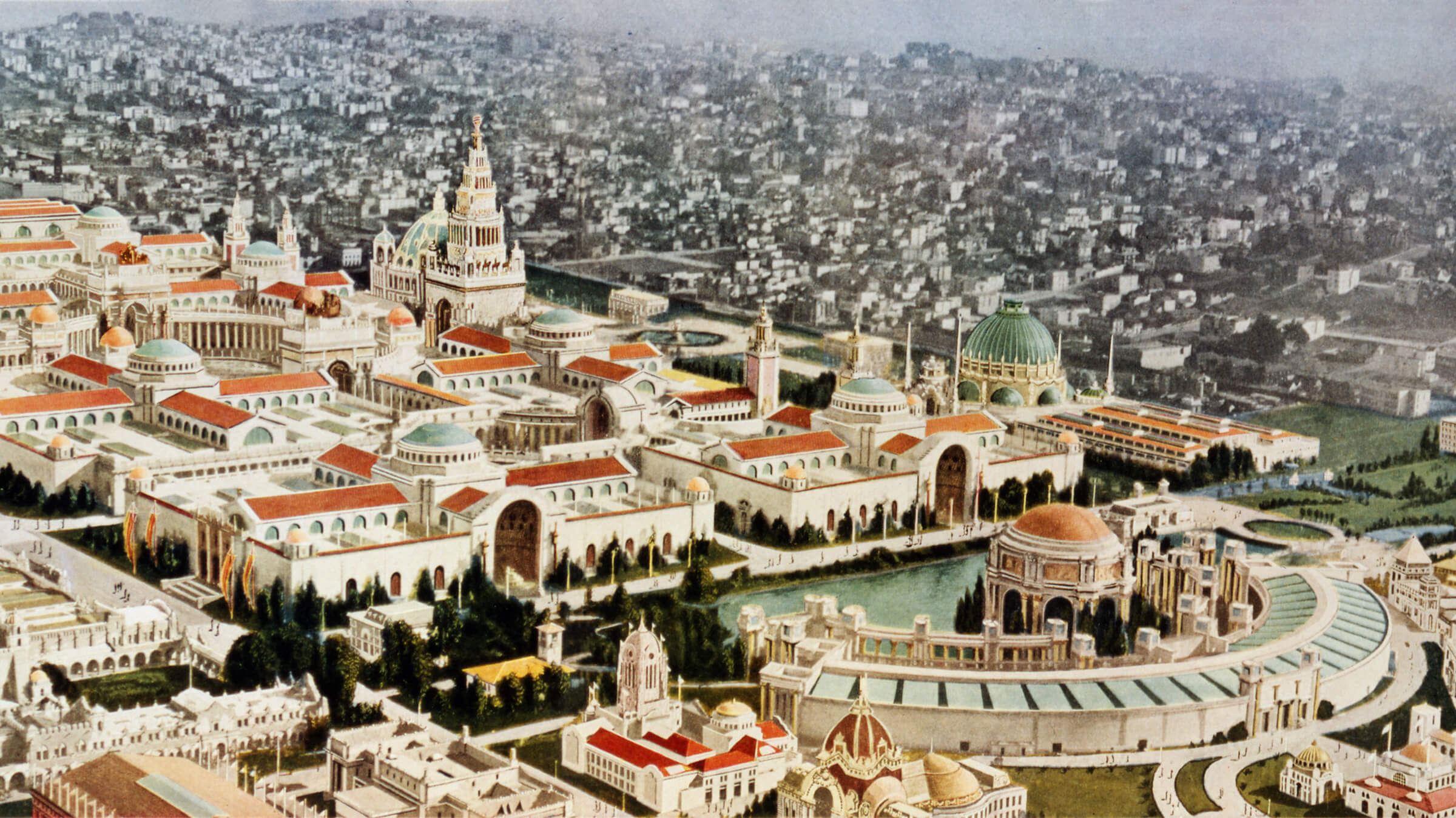ESSANAY SNAGS CHAPLIN
Charles Chaplin had started his career the previous year at Mack Sennett’s Keystone studio but moved to the Essanay Film Manufacturing Company in January with a significant pay hike from $125 a week to $1,250. He made fourteen films with Essanay, many of which were filmed around the San Francisco Bay Area, including 1915’s The Tramp.
EXHIBITION AT THE EXPOSITION
At the San Francisco’s Panama-Pacific International Exposition, which opened on February 20 and ran through December 4, all but one of California’s exhibits on education featured motion pictures of school activities, and films were part of many fair exhibits, including industrial exhibits on copper mining, radium refining, shoemaking, the Railway Mail Service, and the California wine industry, at a peak before the 1920 enactment of Prohibition, which pruned production to grape juice and sacramental wines.
NAKED TRUTH CHALLENGED IN COURTS
A battle over censorship raged all year over the actions of the two-year-old Ohio Censor Board. In a lawsuit filed by the Mutual Film Corporation, the U.S. Supreme Court ruled on February 23 that the free speech protections in the Ohio Constitution did not apply to motion pictures. The same censor board banned Lois Weber’s film Hypocrites, while Boston censors demanded that the full-frontal nudity of one of the film’s characters, called “Truth,” be painted over.
UNIVERSAL CITY’S GRAND OPENING
On March 15, Carl Laemmle inaugurated the Universal City complex, which housed complete facilities to produce films for his distribution company. The groundbreaking had been delayed until June 1914 in order to accommodate the final harvest of oats and barley on the ranch still occupying the 230-acre site. By the end of 1915, Los Angeles was home to sixty percent of U.S. film production.
NAACP SCHOOLS GRIFFITH
D.W. Griffith’s Birth of a Nation had premiered in Los Angeles in early February, but the outrage over the film’s racism came to a head in April when crowds swelled to two thousand in front of Boston’s Tremont Theatre at a protest organized by newspaper editor W. Monroe Trotter. The campaign to have the film banned or censored largely failed, so the NAACP responded by publishing the forty-seven-page educational pamphlet “Fighting a Vicious Film: Protest Against ‘Birth of a Nation,’” which corrected the film’s gross falsehoods. In one of the pamphlet’s statements, biographer John T. Morse wrote, “No one respects history more than I do … but the more I respect it, the more I resent its misuse.”
TECHNICOLOR BEGINS
Through their industrial design consulting firm, Herbert Kalmus, Daniel F. Comstock, and W. Burton Wescott were among several companies already experimenting with a “natural color” photography process. “Technicolor” began its slow seep into the lexicon with the incorporation in 1915 of the Technicolor Motion Picture Corporation, named after Comstock and Kalmus’s alma mater MIT. By the end of the following year, the trio obtained a patent for their first two-color process and, in 1917, showed their short color film The Gulf Between to the public.
LUSITANIA TORPEDOED
Despite warnings to American citizens against sea travel issued by the German Embassy, 128 Americans died on May 7, 1915, when a German submarine attacked and sank British passenger liner RMS Lusitania, killing a total of 1,198 people. British Pathé released newsreel footage of the ship leaving the New York harbor along with reenactment scenes of the disaster and footage of the wreck and survivors. A print of The Carpet from Bagdad, which had opened earlier in the month was onboard, probably as cargo on its way to a distributor’s preview. A single reel of this lost film was recovered from the wreckage in 1982.
THIRD DIMENSION ACHIEVED
Inventors had been testing ideas to project 3D images beginning in the mid-1800s. Edwin S. Porter and W.E. Waddell presented their own “stereoscopic” motion picture demonstration at the Astor Theatre in New York City on the morning of June 10, 1915. The next week Motion Picture World reported: “[T]he long sought after third dimension in photography had been gained … Each member of the audience was provided with glasses, green for the right eye, and red for the left.”
“LONESOME LUKE” BREAKS OUT
Harold Lloyd’s first Lonesome Luke film, Spit-Ball Sadie, was released July 26, 1915. Lonesome Luke was an imitation of Charlie Chaplin’s popular “Little Tramp” character. Lloyd went on to make more than sixty more of these one- and two-reel films before creating his breakout “glasses” character in late 1917. Lloyd biographer Jeffrey Vance writes that the Luke films were so rowdy that the production company had trouble securing insurance to cover the actor.
EDISON TRUST BUSTED
Another court case marked a milestone in film history—the United States vs. Motion Picture Patent Company. Known widely as the Edison Trust, the Motion Pictures Patents Company collected fees for use of their patented equipment, inhibiting the growth of independent producers and exhibitors. The court ruled on October 1, 1915, that the company presented an “unreasonable and undue restraint of trade and commerce” and levied a fine of $20 million.
MATINEE IDOL DEBUTS
John Gilbert was just beginning his screen career with a minor role in Thomas H. Ince’s film The Coward. Eleven years later, he headlined in 1926’s Flesh and the Devil, opposite Hollywood newcomers Greta Garbo and Lars Hanson. At the time of Gilbert’s debut on November 14, Garbo was still a ten-year-old named Greta Gustafsson attending school in a working-class district of Stockholm.
SELIG’S WAR
In December, Selig Polyscope Company released A History of the World’s Greatest War Told in Five Reels of Motion Pictures. While most WWI footage was staged or merely pictures of troop movements, industry magazine Moving Picture World reported about the footage shot by Hearst cameramen in the field: “These intrepid news-picture gatherers photographed the scenes from dangerous positions, along the battle lines in Belgium, East Prussia and other places. Many of the scenes were photographed in the fighting trenches with the allies and with the Germans.”

